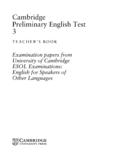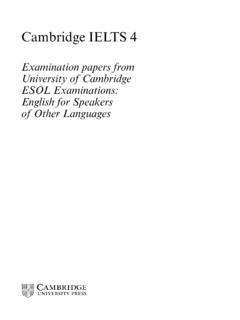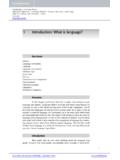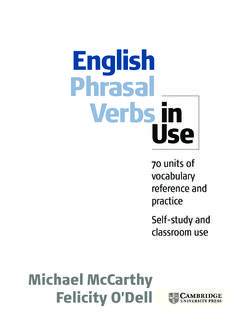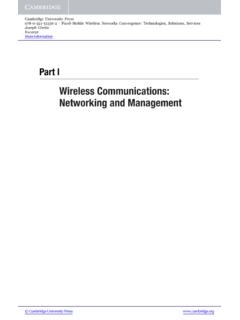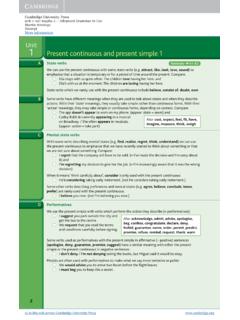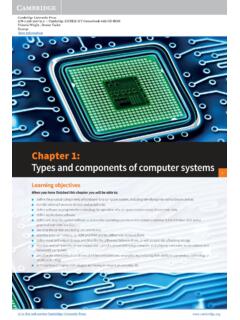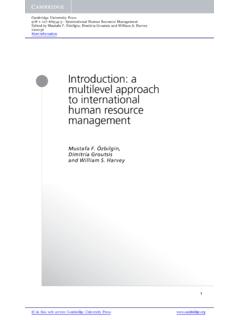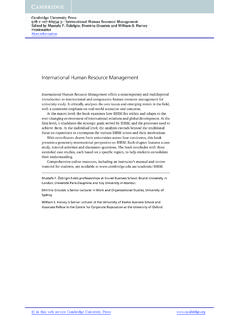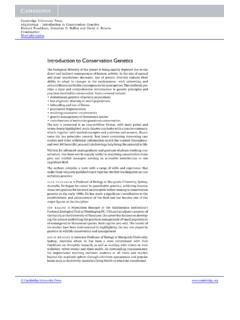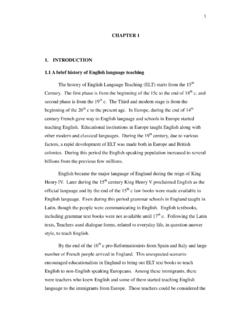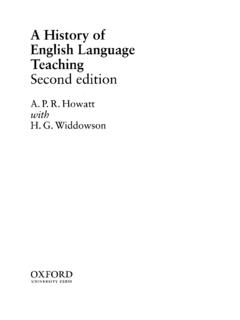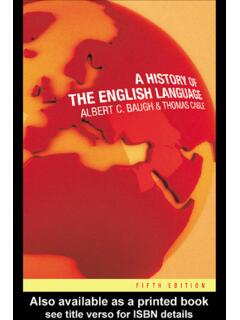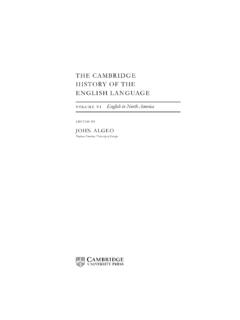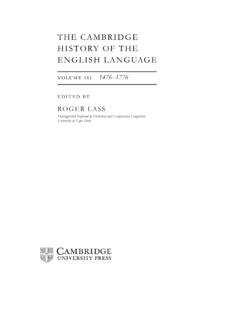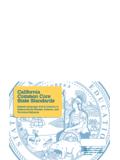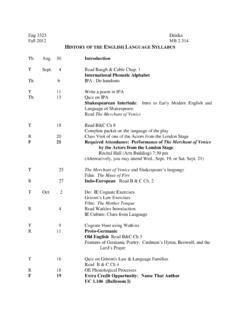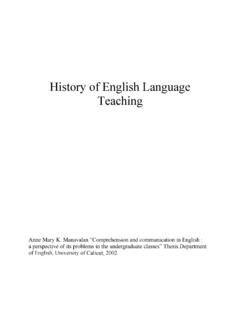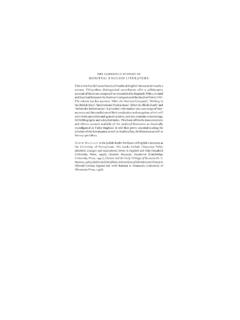Transcription of 1 History:thespreadofEnglish - Cambridge University Press
1 1 history : the spread of INTRODUCTION: THE english language COMPLEXThis book is concerned with an important topic in modern Sociolin-guistics: the globalisation of english and the linguistic consequencesof this process. The rise of english can be studied from a number ofperspectives: as a topic in Historical Linguistics, highlighting the history of onelanguage within the Germanic family and its continual fissioninto regional and social dialects; as a macro-sociolinguistic topic language spread detailing theways in which english and other languages associated withcolonisation have changed the linguistic ecology of the world; as a topic in the field of language Contact, examining the struc-tural similarities and differences amongst the new varieties ofEnglish that are stabilising or have stabilised; as a topic in political and ideological studies -- linguistic impe-rialism -- that focuses on how relations of dominance areentrenched by, and in, language and how such dominance oftencomes to be viewed as part of the natural order.
2 As a topic in Applied Linguistics concerned with the role ofEnglish in modernisation, government and -- above all -- edu-cation; and as a topic in cultural and literary studies concerned with theimpact of english upon different cultures and literatures, andthe constructions of new identities via the 1980s many of these topics have risen to prominence inbooks and journals. Important early studies drawing attention to thisnew field were Bailey and Robinson (1973); Bailey and G orlach (1982);Kachru (1982 and 1986); Pride (1982); and Platt, Weber and Ho (1984).These works were concerned with describing the status and functions1 Cambridge University University Press978-0-521-79733-7 - World Englishes: The Study of New Linguistic VarietiesRajend Mesthrie and Rakesh M. BhattExcerptMore information2world englishesof english around the world and their linguistic characteristics.
3 Theideology behind the spread of english is documented in Richard Bai-ley s (1991)Images of english , Robert Phillipson sLinguistic Imperialism(1992) and in Alastair Pennycook sThe Cultural Politics of english as anInternational language (1994). Two popular books that describe in highlyreadable terms the growth of english and its many manifestations areDavid Crystal s (1997) english as a Global Languageand Tom McArthur s(1998)The english Languages. Mention of collections of articles shouldnot exclude the comprehensive volumes edited by Cheshire (1991),Burns and Coffin (2001) and the Manfred G orlach sequenceEnglishes(1991),More Englishes(1995),Even More Englishes(1998) andStill MoreEnglishes(2002). Accessible introductory books with a sociolinguisticorientation include Jenkins (2003) and Melchers and Shaw (2003). Threelarge handbooks devoted to english throughout the world have largesections devoted to varieties treated in this book: Hickey (2004a), Kort-mannet al.
4 (2004) and Schneideret al.(2004). A handbook devotedentirely to World Englishes in forty-two chapters appeared just as thisbook went to Press (Kachru, Kachru and Nelson 2006). And the growthof interest in english around the world as an academic area of studyfrom the 1980s onwards can be seen in the establishment of three jour-nals that form the mainstay of the field: english World Wide(founded in1979),World Englishes(founded in 1985) and the more popular EnglishToday(founded in 1984). If the field is well served by books and arti-cles, why the appearance of one more? Our motivation for the presentwork is that we feel the time is now ripe for a synthesis of the increas-ing body of research in the area; to identify gaps in the field; and --most importantly -- to emphasise perspectives from other branches ofLinguistics. Platt, Weber and Ho s (1984) book was the only one, to ourknowledge, to attempt a unification of the field by describing the recur-rent features of different varieties.
5 This work was slightly prematurein that it did not have a range of in-depth empirical studies to draw onand consequently reads as somewhat skimming the surface. In fairnessto the authors it could equally be said that they were ahead of theirtime and that they had put their fingers on a number of significantissues. Our inspiration comes from the works cited above, as well asfrom the fields of language Contact (including Creolistics), LanguageAcquisition, and Phonological and Syntactic Theory. As the chaptertitles of this book show, our interest is in the history of the spreadof english , the ideology that promulgated that spread, the structureof the manifold Englishes of the world, the contexts in which thesevarieties emerged, their status, and the educational and social issuesthat surround them. Our main focus (in Chapters 2 to 4) will fall on Cambridge University University Press978-0-521-79733-7 - World Englishes: The Study of New Linguistic VarietiesRajend Mesthrie and Rakesh M.
6 BhattExcerptMore informationIntroduction: the english language Complex3the linguistic forms characteristic of new varieties of english and onways of describing and understanding THE FIELD OF WORLD ENGLISHES The terms most often used to describe the varieties we are interestedin are New Englishes or World Englishes . It has become customaryto use the plural form Englishes to stress the diversity to be found inthe language today, and to stress that english no longer has one sin-gle base of authority, prestige and normativity. There are at least fourbooks bearing the main titleNew Englishes: Pride (1982); Platt, Weberand Ho (1984); Foley (1988) on Singaporean english and Bamgbose,Banjo and Thomas (1997) on West African english . The pluricentrismis also captured in the eye-catching book titleThe english Languages(MacArthur 1998). Yet, as we shall see, neither New Englishes nor World Englishes is an entirely satisfactory term.
7 Kachru (1983a)pointed out that the New english of India was actually older thanEnglish in Australia, which is not generally considered New -- since itis to a large extent a continuation of the norms of nineteenth-centuryfirst- language (henceforthL1)working-class British english . The secondterm World english runs the risk of being over-general, since BritishEnglish is not generally studied within this paradigm. Yet one mightquibble that it is a World english too (from a commonsense notionof the word world , anyway). The term is often cited as parallel to theterm World Music , which covers non-Western musical forms. In allof these terms there is a problem of perspective that is difficult toovercome. It is therefore necessary to find a cover term forallvarietiesof english : the one we will settle for is english language Complex (henceforthELC), suggested by McArthur (2003a:56).
8 The ELC may besaid to comprise all subtypes distinguishable according to some com-bination of their history , status, form and functions. The following listof subtypes, which takes a largely historical point of departure, willbe fleshed out in the rest of this chapter:(a)Metropolitan standards: The termmetropolitan(literally mothercity/city-state ) is an old one, going back to ancient Greece, denot-ing the relation between a state and its colonies. For the ELC theterm would have once been applicable only to standard Englishof England. However, it is uncontroversial today, long after USindependence and its subsequent espousal of distinctly Ameri-can english norms, to acknowledge the existence of at least two Cambridge University University Press978-0-521-79733-7 - World Englishes: The Study of New Linguistic VarietiesRajend Mesthrie and Rakesh M. BhattExcerptMore information4world englishesmetropolitan standard varieties, whose formal models are thoseprovided by the radio and television networks based largely inLondon and US cities like Washington, Los Angeles and (for CNN)Atlanta.
9 (b)Colonial standards: The colonial history of english has made it animportant language in Australia, New Zealand, Canada, SouthAfrica and Northern and Southern Rhodesia (now Zambia andZimbabwe). A fairly large number of english speakers formedan influential group of speakers in the early history of these Dominion territories. The varieties spoken there are referredto in historical dialectology as extraterritorial Englishes. It ispossible to speak of colonial standards since informal and(to a lesser extent) formal varieties have arisen in these ter-ritories that may be considered standard . These standardswere, until recently, not fully accepted within the territories,since the metropolitan standards exerted a the colonial standards are much more prominent asBritish influence recedes.(c)Regional dialects: These are the varieties that may be distinguishedon the basis of regional variation within metropolis and rule of thumb is that the older the settlement of english speak-ers, the firmer the regional differentiation within the english dialects of the UK and USA are clearly definablein regional terms; this is less true of Australia, New Zealand,Canada, South Africa and Zimbabwe.
10 (d)Social dialects: Identifiable varieties within a region along the linesof class and ethnicity may occur. In London there is the dif-ference between Cockney of the working classes, Received pro-nunciation (RP) of the upper-middle class and the intermediate Estuary english (Rosewarne 1994). In Australia linguists identifyBroad, General and Cultivated varieties (Mitchell and Delbridge1965); the first is the most localized, while showing numeroustraces of its origins in British working-class dialects; the thirdis historically oriented towards RP, while the second mediatesbetween these two poles. Amongst ethnolects (or ethnic dialects)Black english (also known as African American english ) is iden-tifiable as a distinct linguistic variety in the USA (though it hassome regional variation too).Groups (a) to (d) are frequently labelled off as a special group, mothertongue or L1 english or english as a Native language (ENL), or inB.
